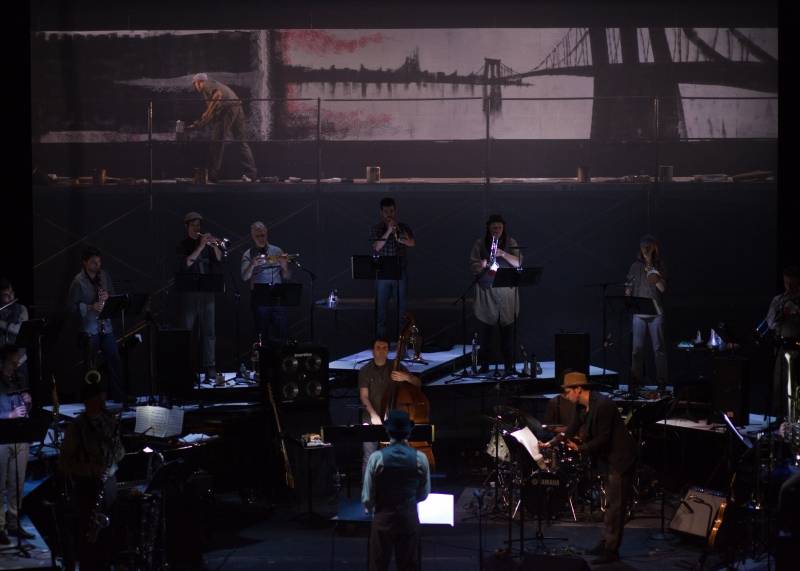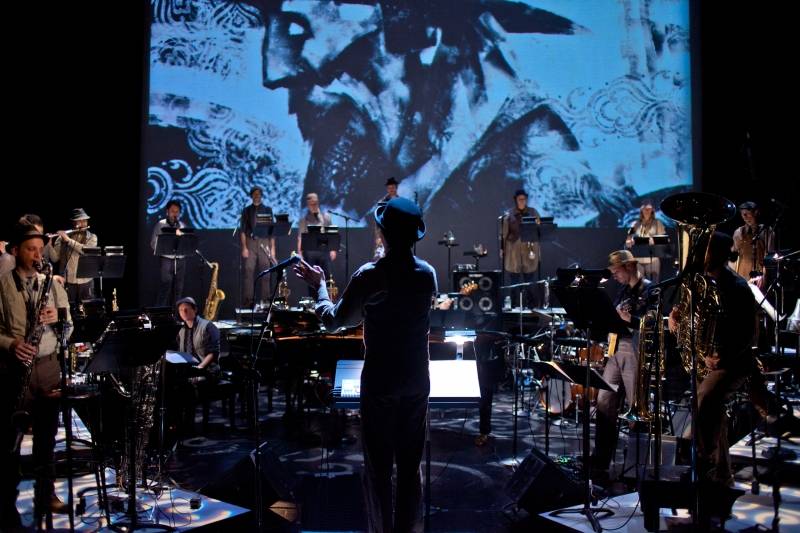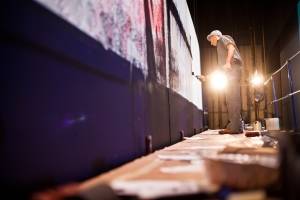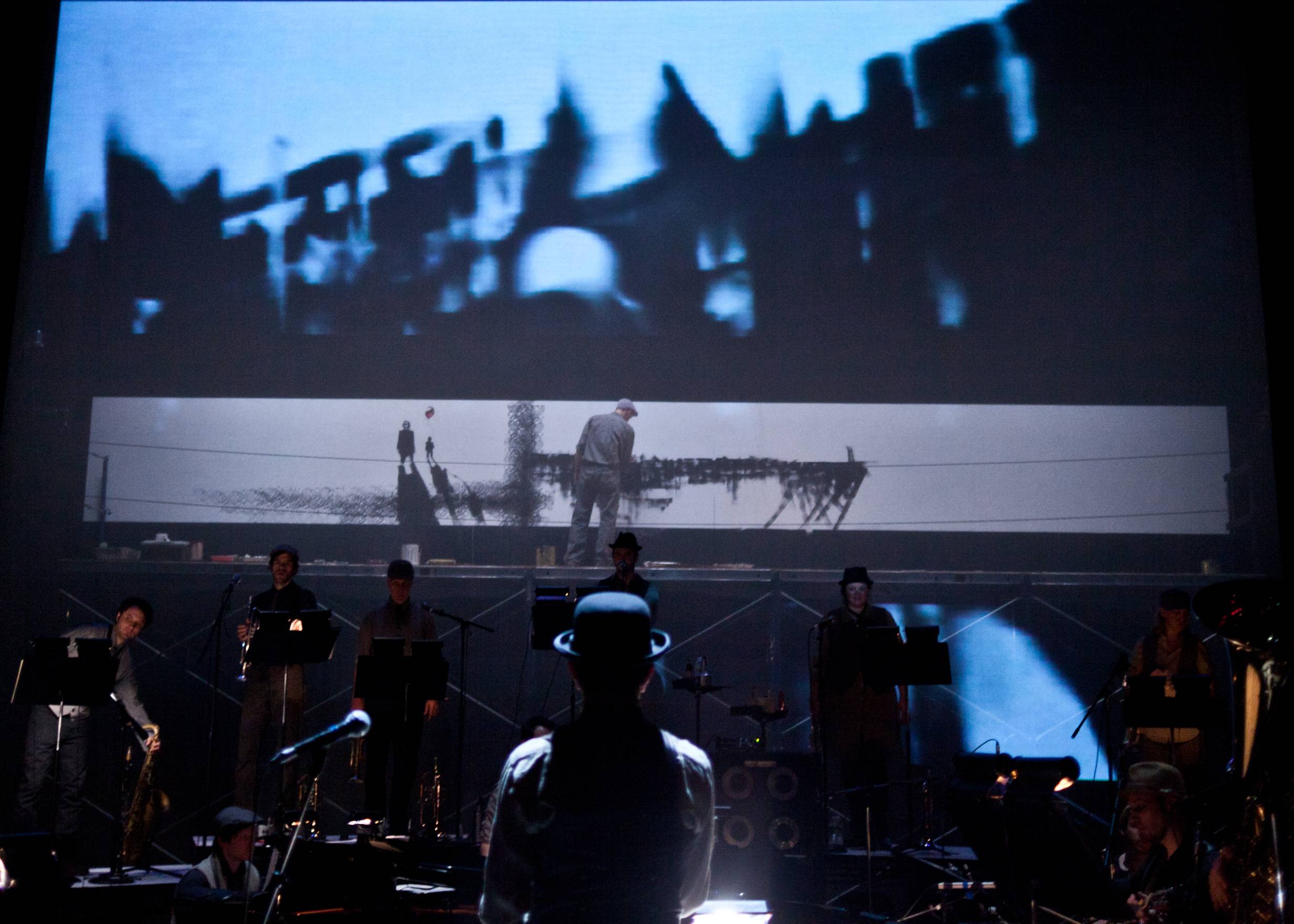There are moments in life we can never replicate, for better or for worse: the moment you said the wrong thing to the right person, the free-throw that sunk as the buzzer sounded, the infinity that spread out the first time you saw Goya’s The Dog at the actual Prada, when Mister Mistoffelees sat on your foot while waiting for curtain call on Broadway. Of course, no matter how mundane or duplicated a moment is, it is arguably, quantumly different, so one could say that any boring TV night or Monday latte is technically unrepeatable. Friday evening’s performance of Brooklyn Babylon, however, is going to fit in better with the first list.

Picture this: an eighteen-piece ensemble, set in a circle of risers, with each member dressed in working-class 1930s clothing. The risers symbolize a carousel that will be set atop the highest skyscraper in all the world, which is being built in a potential-future Brooklyn. The musicians play the sounds of that amalgam of cultures, time periods, and styles that have been marinating in the melting pot of Brooklyn for centuries (I did say the future. Centuries, plural.) Nearby, animations are projected, wordlessly narrating the story that the band is making you feel — a tale of risk versus reward, sacrifice justifying ends. And behind them, one man paints an incredible scene on a canvas that measures thirty feet long by four feet high, bringing that future city into visual reality right in front of you. You’re captivated for nearly an hour, bombarded with gorgeous sights, award-winning sounds, paint-fume smells, the feels of the story.
And then he paints over it.
It’s gone.
Irreplaceable.
(I’ll give you a minute)
 This collaboration between Darcy James Argue and artist Danijel Zezelj has been performed less than a half-dozen times, and they will be bringing this extraordinary work to the Krannert Center for the Performing Arts this Friday, November 13th. Our community will be one of a very few able to witness this unique and singular expression, gestalt even, between music and art.
This collaboration between Darcy James Argue and artist Danijel Zezelj has been performed less than a half-dozen times, and they will be bringing this extraordinary work to the Krannert Center for the Performing Arts this Friday, November 13th. Our community will be one of a very few able to witness this unique and singular expression, gestalt even, between music and art.
The story is simple, ancient, and futuristic. A skyscraper is being built in Brooklyn, it will be the tallest in the world. It needs a crowning achievement. Local master carpenter, Zev Bezdomni, is enticed to build a carousel at its apex, but in doing so, cannibalizes the mixed heritage of his own  neighborhood. The author as well as illustrator, Zezelj cites Pieter Bruegel’s paintings of the Tower of Babel as formative in his life, and partial inspiration for the story, which was eventually released as a graphic novel, “Babilon” in Europe. Regarding the pertinence such an archaic story could have for current and future generations, he replies,
neighborhood. The author as well as illustrator, Zezelj cites Pieter Bruegel’s paintings of the Tower of Babel as formative in his life, and partial inspiration for the story, which was eventually released as a graphic novel, “Babilon” in Europe. Regarding the pertinence such an archaic story could have for current and future generations, he replies,
“Biblical stories are often parables for what’s going on around us here and now. We are fooled by technology but we didn’t progress as far as we think we did, and our struggles and hopes didn’t change much. There was a Brooklyn in an ancient world and there were good people and greedy people, our fights are the same, it’s just our shoes and cars that are getting shinier.”

Taking his cue from Danijel’s illustrations, Argue wanted the music to combine that eternal timelessness with past eras and imaginary future ones, blending cultures and sounds to create images nearly as concrete as the ones being painted on stage. In my first listen, I heard influences from East Asia, the Mediterranean, Latin America, and Eastern Europe, metal and hip-hop. I imagined a moon base that attracted every Earthly culture, and then hosted a rave. These musical themes, according to the composer, are meant to portray the immigrant carpenter’s experience adjusting to a rapidly changing urban landscape, while others are to reflect the history and future of the Brooklyn we know. “I tried to include at least a little bit of everything I love about Brooklyn’s incredibly vibrant and varied music scene,” says Argue, listing an incredible number of genres of music. Something about it worked, because not only has it been nominated for a GRAMMY, a JUNO, and topped jazz best-of lists, but it’s on near-constant rotation in my playlists.
 Founder of “Secret Society”, a self-proclaimed steampunk bigband with 18 performers, Darcy James Argue explains that rather than a literal interpretation of the descriptor, he intended the term to be more imaginative than literal, “My vision for the band was to take an antique instrumentation — the jazz bigband, whose heyday came and went almost 80 years ago — and refashion it for contemporary purposes.” Although when I asked about the steampunk aspect of this performance, the musician replied, “What’s more steampunk than brass tubes with movable slides and piston valves, fired by hot air?” Touche´ Mr. Argue.
Founder of “Secret Society”, a self-proclaimed steampunk bigband with 18 performers, Darcy James Argue explains that rather than a literal interpretation of the descriptor, he intended the term to be more imaginative than literal, “My vision for the band was to take an antique instrumentation — the jazz bigband, whose heyday came and went almost 80 years ago — and refashion it for contemporary purposes.” Although when I asked about the steampunk aspect of this performance, the musician replied, “What’s more steampunk than brass tubes with movable slides and piston valves, fired by hot air?” Touche´ Mr. Argue.
The music telling a story, even a story written by a different person, is hardly new or boundary-pushing. What brings this show into the realm of the uncommon is the multimedia and live-painting aspect. As someone who has painted onstage before, with his composer wife, Jessica Lurie, Zezelj’s practiced hand may make all the difference. Knowing how few times Brooklyn Babylon has been performed, I was curious as to whether each painting was the same, or if the artist allowed the music to  move him uniquely at each show. Explaining that each movement had to coordinate with the music and animation, thus is precisely timed, he admitted most of the paintings were similar before going on to say, “However, performance is a live organism, especially with such a big band, so every painting is different. My feeling is that each time we do Brooklyn Babylon we do it for the very first time, and that we will never be able to do it again.”
move him uniquely at each show. Explaining that each movement had to coordinate with the music and animation, thus is precisely timed, he admitted most of the paintings were similar before going on to say, “However, performance is a live organism, especially with such a big band, so every painting is different. My feeling is that each time we do Brooklyn Babylon we do it for the very first time, and that we will never be able to do it again.”
Darcy James Argue agrees, stating that his wish for each audience member is to be “…left with the feeling of an all-encompassing live event — something that can never be repeated exactly the same way, an experience that could not be reproduced by any other means.” Mission accomplished when you end the performance with an act of artistic destruction that surpasses even the willful destruction of mandalas by monks. The painter tried to rationalize, saying that since the narrative is about the loss of a crucial part of oneself, “the act of destruction of the painting brings out the feel of permanent loss, it makes it concrete, tactile. Also, the uniqueness of performance is in creating something that happens only once, at that single moment in space.”
I know I will be heartbroken. When it comes to emotional manipulation by artistic acts of destruction, I am incredibly vulnerable (I still hold a grudge against Buddhist monks… monks!). But I am prepared, because to me the experience of witnessing the act of creation, and the privilege of going on this journey with Zev Bezdomni, far outweighs the price of admission.
Join me at the single and singular performance of Brooklyn Babylon this Friday, November 13th, at 7:30 p.m. in the Tryon Festival Theatre. Tickets start at $27, with discounts for groups, seniors, and non-University students. As always, youth and Illinois student tickets are $10.








